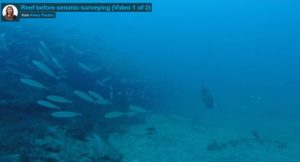Rutgers professor of Estuary and Marine Ecology. And OCR friend Judith Weis sent us an article about how the environmental health can be determined by listening. The paper by Katherine Indeck (et al.) described in the article explored the sounds of a reef system during an episode of “Harmful Algal Bloom” (Red Tide), and the reef sounds at the same times of year and day when there was no Red Tide. It is pretty easy to hear that while there is a gain difference between the two recordings, the soundscapes differ radically in terms of abundance of sound sources.
It has been somewhat recently that the terms “soundscape” and “biophany” have entered into the scientific vocabulary, probably because they are terms that are hard to quantify. But as we begin to evaluate ecosystems, terms like these become platforms of discovery – from where quantifiable data can be assessed.
The ocean can be a really noisy place – with crashing waves, lightning strikes, earthquakes, calving icebergs, and rough weather. And then there are the animals: Whales banging and crooning, fish chortling and drumming, lobsters creaking, barnacles whistling, and shrimp snapping. A number of years ago we produced a paper on this – looking at the historic noise levels of the ocean before industrialized whaling.
We were examining a time before hydrophone recordings, so we built a mathematical model; and if the model is to be believed, the ocean was really noisy in 1820 (even louder than it is now!), mostly due to the phonations of the millions of whales that were around before they were all killed off. But the loud noises of yore were not bad noises. One of the operating premises of biophany and healthy soundscapes is the idea of “acoustical niches,” wherein animal density spreads out into the habitat, taking up to their adaptive niches, and leaving other niches in which other animals dwell.
Under this premise a heathy biophonic soundscape sounds like a full orchestra – with basses and tympani holding the low notes, celli and French horns filling in the middle, and flutes, clarinets, and glockenspiels coming up out of the top. It can get pretty loud, but in this case “loud” is not necessarily “bad.” Where problems crop up is when noisy neighbors move in – in this case us humans, with really loud broad-band noise that crowds out all of the acoustical niches.
An example of this was also recently published paper (Amy Paxton et al.) about how seismic airgun surveys caused 78% of the fish in reef habitat to depart. This study included pretty dramatic video footage of before and during shallow water seismic surveys. Unfortunately for the sake of the study the batteries were not up to the task of determining if and when the fish returned. But there is a lot that can be derived from this study.
While there is a lot of literature on how seismic surveys disrupt marine mammals, there is a paucity of data on seismic survey impacts on fish. This shallow water study is pretty unambiguous: Seismic surveys seriously disrupts fish habitats – crowding out the healthy song of the sea.


